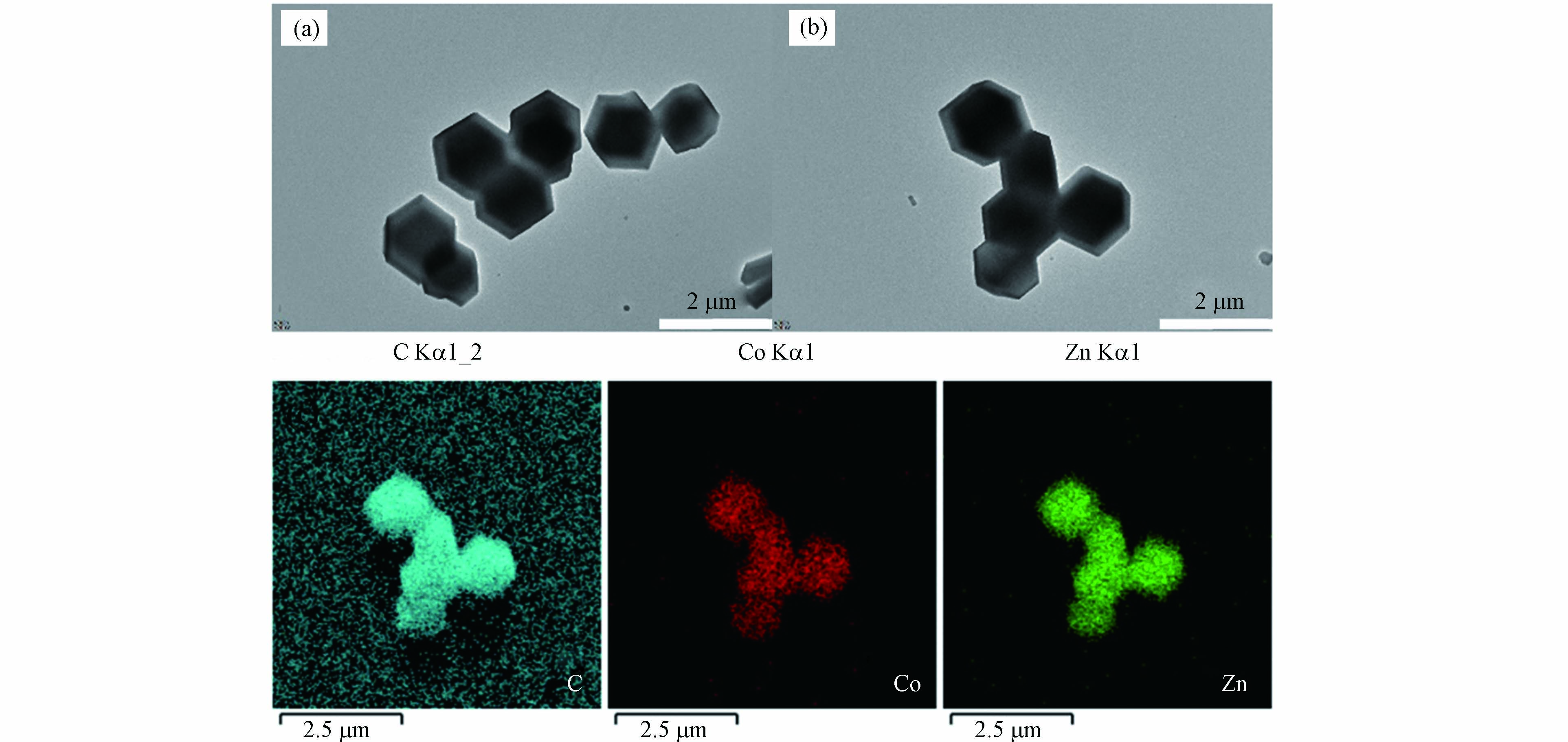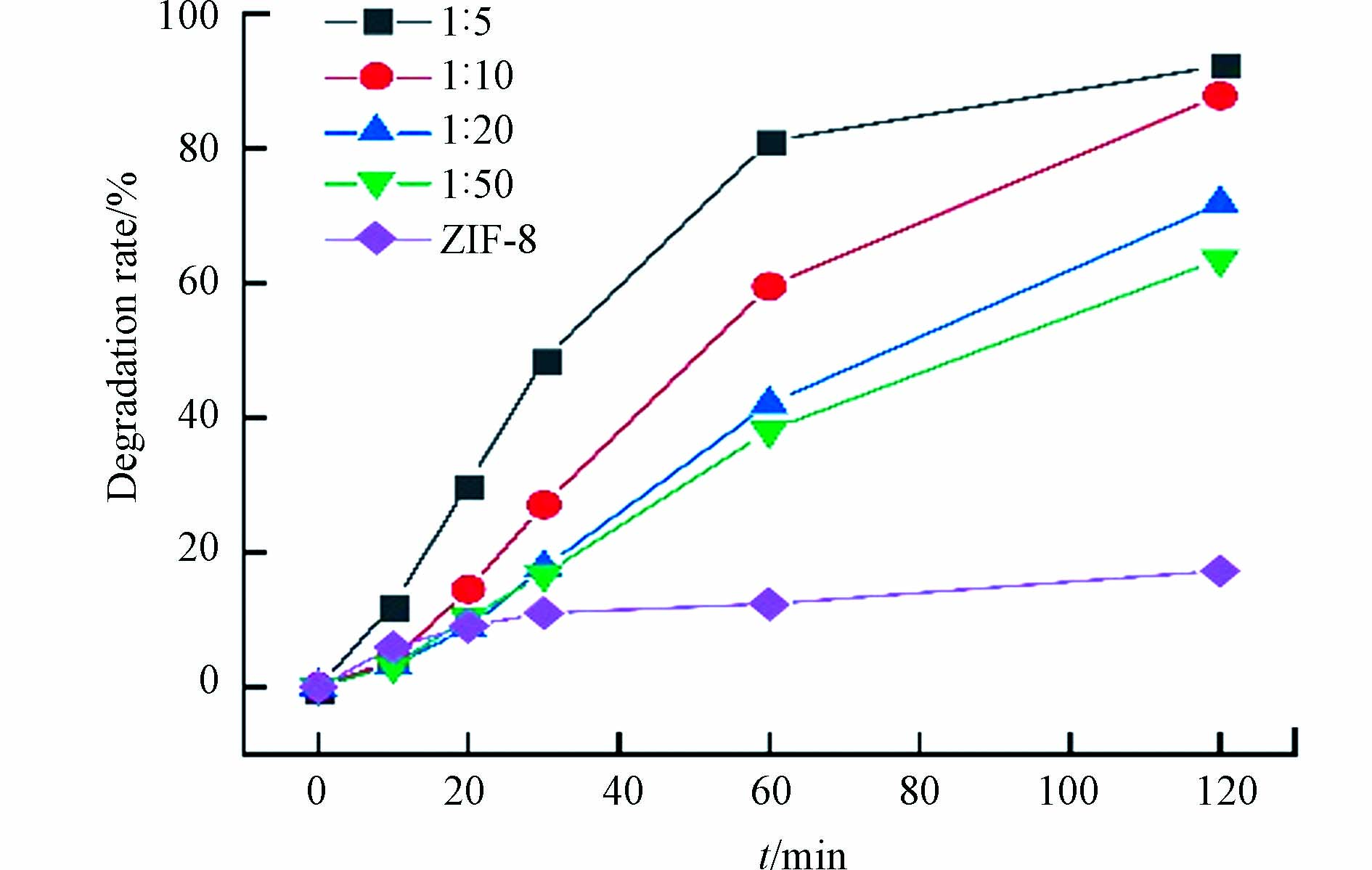-
随着制药工业的快速发展,抗生素在土壤和地表水中被广泛检出,引起了诸多关注. 诺氟沙星(NOR)作为第三代氟喹诺酮类药物被广泛应用于医疗领域[1]. 由于其难降解的特性,在水生生态系统中持续累积,会导致细菌耐药性的形成和扩散,威胁到人类健康和生态平衡[2-3]. 因此,亟待开发一种简单、高效且低成本的降解转化NOR的方法.
高级氧化工艺(AOPs)目前被广泛应用于处理难降解污染物,其中过硫酸盐活化过程中由于其产生的硫酸根自由基(SO4•−)具有氧化还原电位更高(E0=2.5—3.1 V),自由基寿命更长的特点(t1/2=30—40 μs)而受到广泛关注. 然而,低PMS的自分解速率限制了生成的SO4•−的产量. 因此,为了提高污染物去除性能,应开发一种有效的PMS激活方法. 金属有机框架(MOFs)具有高比表面积、大孔容、高化学稳定性等特点[4-5]. 其中ZIFs及其衍生物对过一硫酸盐具有很高的催化活性,可以有效降解许多难降解有机污染物,如王渊源等[6]利用ZIF-67活化PMS降解罗丹明B;Wang等[7]利用热处理后的ZIF-8催化降解气态甲醛,取得了良好的效果. 然而单一金属基ZIFs的活性位点相对较少,催化性能一般;高度分散的ZIFs纳米颗粒难以从悬浮体系中分离出来,导致催化剂回收率低、不可重复使用和二次污染,这限制了它们在环境中的实际应用.
针对上述问题,采用静电纺丝结合原位生长法制备了双金属沸石型咪唑骨架CoZn-ZIF/PAN纳米复合纤维. 电纺纳米纤维具有大孔隙率、高比表面积和良好的稳定性,是负载ZIFs晶体的理想骨架[8-9]. 并且以纤维膜形式存在的ZIFs材料可以有效避免催化离子聚集的现象,易于从反应体系中分离、回收和再利用[10-11]. CoZn-ZIF纳米颗粒被成功地固定在电纺PAN纳米纤维上,形成致密的葡萄串纳米纤维,这种设计有效地增加了材料的比表面积,使纳米颗粒上的活性位点充分暴露,显著提高了纳米复合纤维膜的催化效率,提升了材料的稳定性.
-
氧化锌(ZnO)、聚丙烯腈(平均分子量15000)、六水硝酸钴(Co(NO3)2·6H2O)、无水醋酸锌(Zn(OAc)2)、过硫酸氢钾(KHSO5,PMS)购于上海阿拉丁生化科技股份有限公司;2-甲基咪唑(2-MI)、NOR(NOR)和叔丁醇(TBA)均购于上海麦克林生化科技股份有限公司;N, N-二甲基甲酰胺(DMF)购于西陇科学股份有限公司;无水甲醇(MeOH)、乙醇购于科试公司;硝酸(HNO3)、氢氧化钠(NaOH)购于国药集团化学试剂有限公司. 所有的试剂未经进一步纯化直接使用.
-
取适量ZnO加入到10 mL DMF中,超声使ZnO充分分散在DMF中,向其中加入1 g PAN(ZnO干物质质量为PAN质量的20%),60 ℃加热搅拌6 h,使聚合物充分溶解形成均一的ZnO/PAN溶液,将所得溶液注入到注射器中,采用21G针头,溶液流量为1.5 mL·h−1,电压为19 kV,接收距离为15 cm,收集无纺布上纤维膜,置于60 ℃真空干燥箱中,挥发残留溶剂8 h,得到ZnO/PAN纤维膜.
-
称取1.8346 g Zn(OAc)2溶解于40 mL甲醇中(A液),0.5821 g Co(NO3)2·6H2O溶于40 mL甲醇中(B液),5.747 g 2-MI溶解于40 mL甲醇中(C液),然后将A液与B液充分混合后倒入C液. 搅拌5 min后,取适量PAN/ZnO纤维膜,加入到上述混合溶液中,密封,30 ℃条件下反应16 h,将反应后的纤维膜取出,先用甲醇冲洗,去掉表面附着的ZIF,再加入到盛有甲醇的烧杯中,在超声清洗机中超声洗涤5 min后,给烧杯中更换甲醇,重复3次,然后用无水乙醇淋洗,置于鼓风干燥箱中,常温风干3 h,转移至真空干燥箱中,60 ℃烘干3 h,制得CoZn-ZIF原位生长的复合纤维膜.
-
通过扫描电子显微镜(SEM,Regulus 8230,Hitachi,日本)和透射电子显微镜(TEM,JEM-2100F,日本电子株式会社,日本)对材料微观形貌进行分析;通过X射线衍射仪(XRD,Rigaku SmartLab SE,日本)对材料进行晶体表征;通过X射线光电子能谱仪(XPS,Thermo Scientific K-AlpHa,美国)分析材料的元素组成;采用美国Micromeritics ASAP 2460全自动比表面积及孔径分析仪测定目标材料的N2等温吸脱附曲线;使用单点BET和BJH方法计算材料的比表面积、孔体积以及孔径分布;采用国仪量子CIQTEK EPR200-Plus顺磁共振波谱仪进行自由基类型的分析.
-
采用PMS活化法降解NOR来评价催化剂活性. 类芬顿反应是在间歇反应器玻璃烧瓶中进行的. 用0.01 mol·L−1 HCl或0.1 mol·L−1 NaOH溶液调节初始pH. 具体操作为:将0.1 g催化剂添加到1000 mL的10 mg·L−1 NOR溶液中,然后加入0.2 g PMS在固定的时间间隔内,用注射器抽出5.0 mL的反应溶液,经0.45 μm的微孔膜过滤后转移到样品管中. 使用紫外-可见分光光度计在波长277 nm处测量NOR吸光度,进而得到NOR的浓度. 以芬顿反应的一级动力学模型为基础,推导出芬顿反应的速率常数:
其中,C0和C分别为反应初始和反应后污染物浓度;t为反应时间.
-
CoZn-ZIF颗粒的形貌通过TEM进行了分析,如图1所示,CoZn-ZIF颗粒大小均匀,呈现出正十二面体结构,与ZIF-8结构形态相似[12]. C,Co,Zn元素均匀地分布在颗粒内部,说明CoZn-ZIF双金属ZIF颗粒的成功制备.
未经任何处理的ZnO/PAN纤维膜表面的FESEM如图2a所示. 由图2a可见,ZnO/PAN纤维表面光滑无断裂,粗细均匀无串珠,多数纤维直径在200 nm左右. 在经过原位生长处理后,纤维表面长满了三维正十二面体结构的颗粒(图2b). CoZn-ZIF颗粒已经被成功地负载到了PAN纤维上.
利用XRD和XPS进一步分析了CoZn-ZIF/PAN纳米纤维材料. 由图3a可知,ZIF-8和CoZn-ZIF特征峰几乎一致,在7.30°、10.35°、12.70°、14.80°、16.40°和18.00°位置出现的峰与(011)、(002)、(112)、(022)、(013)和(222)所代表的晶面对应,说明 CoZn-ZIF仍保持着ZIF-8的晶体结构特征. 与CoZn-ZIF相比,虽然CoZn-ZIF/PAN部分特征峰不明显或消失,但整体趋势仍相仿,可能是CoZn-ZIF/PAN表面的CoZn-ZIF颗粒少部分被遮盖造成的. CoZn-ZIF颗粒的XPS分析可以看出该物质中存在C、N、Co、Zn等元素:1021.8 eV和1044.4 eV对应Zn2+,782.0 eV和778.7 eV对应Co2+和Co0(图3b)[13-14]. 进一步证实了复合材料中Zn和Co的共存,这意味着成功合成了CoZn-ZIF复合材料.
CoZn-ZIF/PAN复合纳米纤维膜与ZnO/PAN膜的N2吸附解吸曲线对比发现,CoZn-ZIF/PAN材料明显比ZnO/PAN的吸附量大(图4a),两种材料的孔径分布图对比可知,CoZn-ZIF/PAN的平均孔径更小(图4b),说明CoZn-ZIF的加入为材料带来了大量的微孔结构,大大提高了材料的比表面积.
表1显示了不同纤维材料的比表面积和孔隙特征,CoZn-ZIF/PAN纳米复合纤维膜BET比表面积为414.6892 m²·g−1,总孔容0.258235 cm3·g−1,平均孔径为3.0662 nm. 与原始ZnO/PAN纤维膜相比,其比表面积增大了1758.13%. 显然CoZn-ZIF/PAN具有更大的比表面积,能够为催化反应提供大量的活性位点,并且孔体积丰富,能够使得催化界面充分暴露,具有更高的催化活性.
-
在CoZn-ZIF/PAN/PMS类芬顿体系中,不同钴锌比的催化剂对NOR的降解率如图5所示. 在不添加Co的情况下,ZIF-8/PAN对NOR基本没有催化能力,而随着Co的掺杂比例增大,NOR的降解率从63.6%逐步增加到92.3%. 可见双金属ZIF比单一金属制备的ZIF催化性能更高,这是由于两种金属的协同效应减少了反应过程中的电荷传输阻力,使能量传递更加高效. 当Co:Zn从1:10增加到1:5时,降解率虽略有提升但都维持在90%左右. 这是由于过量的Co掺杂导致Co离子聚集,反而会影响催化效率. 因此后续实验选用钴锌比1:5的CoZn-ZIF/PAN作为研究对象,探讨不同条件对其催化降解NOR的影响.
-
在NOR浓度为10 mg·L−1,pH=7和CoZn-ZIF/PAN的投加量为0.1 g·L−1的初始条件下,探究了PMS投加量对CoZn-ZIF/PAN膜催化性能的影响. 由图6a可知,在PMS投加量为0的情况下,系统内CoZn-ZIF/PAN膜对NOR的吸附作用起主要作用,此时NOR的去除率不足30%. 随着PMS投加量由0.02 g·L−1增加至0.2 g·L−1,CoZn-ZIF/PAN对NOR的降解率由48.7%增加至92.3%,而随着PMS投加量进一步增至0.4 g·L−1时,NOR的降解率却仅增加了2.9%. PMS投加量超过0.2 g·L−1后,NOR的降解率并没有得到显著提升,考虑实际应用的成本问题,最后选定PMS的最佳投加量为0.2 g·L−1.
在NOR浓度为10 mg·L−1, PMS投加量为0.2 g·L−1,CoZn-ZIF/PAN的投加量为0.1 g·L−1的初始条件下,探究了不同初始pH值对CoZn-ZIF/PAN降解NOR性能的影响. 由图6b可知,当pH分别为3、5、7、9、11时,其对应的NOR的降解率分别为89.0%、92.2%、92.3%、90.2%、38.9%,说明CoZn-ZIF/PAN在pH值为3—9时均有较高的催化活性,最佳初始pH条件为5—7. 与其他类芬顿催化剂相比,CoZn-ZIF/PAN具有更宽的pH适用范围.
-
催化剂的稳定性对于其实际应用具有重要意义. CoZn-ZIF/PAN复合纤维膜由于其机械性能良好,易于从反应体系中进行分离,实际应用方便. 图7a显示了CoZn-ZIF/PAN循环3个周期后,CoZn-ZIF/PAN对NOR的降解效率仍高于80%. 同时,Co离子的浸出浓度远低于国家标准(2 mg·L−1),说明了材料具有很好的稳定性和环境友好性.
-
为了进一步揭示CoZn-ZIF/PAN活化PMS的反应机制,分别采用自由基淬灭和EPR分析催化降解过程中产生的自由基(图8). 由图8a可知,以DMPO为捕获剂时,单独添加PMS体系中,未见明显的自由基信号;而引入CoZn-ZIF/PAN后体系中可见明显的近似1:2:1:2:1:2:1的自由基信号峰,说明存在•OH和SO4•−.
为明确降解NOR的主要活性物种,分别用叔丁醇(TBA)和甲醇(MeOH)作为淬灭剂进行自由基淬灭实验(图8b). 已知TBA只对•OH有淬灭作用,而MeOH对•OH和SO4•−都有淬灭作用. 由图8b可知,使用TBA淬灭后,NOR的降解率仍高达90.5%,而使用MeOH淬灭后,NOR的降解率仅为12%左右. 由此可见CoZn-ZIF/PAN/PMS体系产生降解NOR的主要活性物种为SO4•−.
结合自由基淬灭实验、EPR分析和类似研究,推导出CoZn-ZIF/PAN活化PMS降解NOR的可能过程为:CoZn-ZIF/PAN中的Co2+与PMS中的HSO5−反应生成SO4•−和Co3+,而Co3+又与HSO5−反应生成SO5•−和Co2+,实现了Co离子的循环. 同时少量的SO4•−与OH−结合生成•OH和SO42−(式1—3)[15-16].
-
采用原位生长法,将CoZn-ZIF这种双金属有机骨架负载在柔性PAN纤维上,并研究了其对PMS的催化性能. SEM、XRD、XPS等微观及结构表征证明了CoZn-ZIF双金属有机骨架的成功制备和负载. CoZn-ZIF/PAN催化PMS降解NOR的实验证明,CoZn-ZIF/PAN可以催化PMS产生SO4•−自由基降解NOR;钴锌原子比为1:5时催化效果最佳,NOR的降解率高达92.3%;CoZn-ZIF/PAN对溶液的pH适应性强,在pH值为3—9的宽范围内对NOR的降解率均为90%左右. 循环实验及离子浸出实验证明CoZn-ZIF/PAN易于回收且具有一定的稳定性和重复利用性. 综上所述,CoZn-ZIF/PAN在类芬顿催化领域具有较好的应用前景.
原位生长的双金属CoZn-ZIF/PAN纳米复合纤维膜催化降解诺氟沙星
In situ growth of bimetallic CoZn-ZIF/PAN nanocomposite fiber membranes catalyzes the degradation of norfloxacin
-
摘要: 针对高级氧化技术中催化材料活性位点单一,pH值使用范围窄,难以回收利用的难题,采用静电纺丝结合原位生长法制备了双金属CoZn-ZIF/PAN纳米复合纤维膜,用于催化过一硫酸盐降解诺氟沙星(NOR). 光谱结合能谱分析结果显示CoZn-ZIF纳米颗粒被成功地固定在电纺PAN纳米纤维上. 与空白纳米纤维相比,双金属CoZn-ZIF颗粒使得CoZn-ZIF/PAN膜具有更大的比表面积,为催化反应提供了大量的活性位点. 随着Co掺杂比例的增大,NOR的降解率增加;在pH 3—9范围内,CoZn-ZIF/PAN复合纳米纤维膜催化PMS对诺氟沙星的降解率达到90%以上,且最佳的pH工作条件为中性范围,更有利于该纳米复合纤维膜的实际应用. 循环试验显示3个循环周期后,CoZn-ZIF/PAN对NOR的降解效率仍高于80%,而Co离子的浸出浓度远低于2 mg·L−1,说明了该纳米复合纤维膜材料具有优异的循环性和稳定性. 利用原位生长的方式实现CoZn-ZIF/PAN纳米复合纤维膜的构建是实现类Fenton反应高效运行的可行策略.Abstract: Advanced oxidation technology are hindered by the poor catalytic activity of single-site catalysts, acidic circumstance necessary, and difficult recycling of catalytic materials. In this work, bimetallic CoZn-ZIF/PAN nanocomposite fiber membranes were prepared by electrospinning combined with in situ growth strategy to catalyze the norfloxacin (NOR) degradation by permonosulfate. The spectral binding energy spectroscopy results showed that CoZn-ZIF nanoparticles were successfully immobilized on electrospun PAN nanofibers. Compared with blank nanofibers, the CoZn-ZIF/PAN membrane have larger specific surface area, which provide a large number of active sites for catalytic reactions. With the increase of the Co-doping ratio, the degradation rate of NOR increased. In the pH 3—9 range, the degradation rate of NOR catalyzed by CoZn-ZIF/PAN membrane reaches more than 90%, and the optimal pH working conditions are neutral range, which is more conducive to the practical application of the nanocomposite fiber membrane. The cycling test showed that the degradation efficiency of CoZn-ZIF/PAN for NOR was still higher than 80% after three cycles, while the leaching concentration of Co ions was much lower than 2 mg·L−1, indicating that the nanocomposite fiber membrane material had excellent cycling and stability. The construction of CoZn-ZIF/PAN nanocomposite fiber membrane with in-situ growth strategy is a feasible tactics to achieve efficient operation of Fenton-like reactions.
-
Key words:
- electrospinning /
- metal-organic framework /
- catalysis /
- advanced oxidation.
-

-
表 1 ZnO/PAN和CoZn-ZIF/PAN的比表面积及孔径分析
Table 1. Specific surface area and pore size analysis of ZnO/PAN and CoZn-ZIF/PAN
样品
SampleBET表面积/(m 2 ·g−1)
SBET微孔体积/(cm3·g−1)
Microporous volume平均孔径/nm
Average pore diameters总和
Total微孔
Microporous介孔
MesoporeZnO/PAN 22.3175 19.5721 2.7454 0.002560 24.5778 CoZn-ZIF/PAN 414.6892 391.6709 23.0184 0.258235 3.0662 -
[1] ZHUANG Y, LUAN J F. Improved photocatalytic property of peony-like InOOH for degrading norfloxacin [J]. Chemical Engineering Journal, 2020, 382: 122770. doi: 10.1016/j.cej.2019.122770 [2] YIN N, CHEN H Y, YUAN X Z, et al. Highly efficient photocatalytic degradation of norfloxacin via Bi2Sn2O7/PDIH Z-scheme heterojunction: Influence and mechanism [J]. Journal of Hazardous Materials, 2022, 436: 129317. doi: 10.1016/j.jhazmat.2022.129317 [3] WANG G, ZHAO D Y, KOU F Y, et al. Removal of norfloxacin by surface Fenton system (MnFe2O4/H2O2): Kinetics, mechanism and degradation pathway [J]. Chemical Engineering Journal, 2018, 351: 747-755. doi: 10.1016/j.cej.2018.06.033 [4] WANG Q, ASTRUC D. State of the art and prospects in metal-organic framework (MOF)-based and MOF-derived nanocatalysis [J]. Chemical Reviews, 2020, 120(2): 1438-1511. doi: 10.1021/acs.chemrev.9b00223 [5] WANG C H, ZHENG T, LUO R, et al. in situ growth of ZIF-8 on PAN fibrous filters for highly efficient U(Ⅵ) removal [J]. ACS Applied Materials & Interfaces, 2018, 10(28): 24164-24171. [6] 王渊源, 阎鑫, 艾涛, 等. 碳化三聚氰胺泡沫负载ZIF-67活化过硫酸氢钾降解罗丹明B [J]. 材料导报, 2022, 36(17): 193-199. WANG Y Y, YAN X, AI T, et al. Carbonized melamine foam loaded with ZIF-67 activated peroxymonosulfate for degradation of rhodamine B [J]. Materials Reports, 2022, 36(17): 193-199(in Chinese).
[7] WANG T Q, WANG Y F, SUN M Z, et al. Thermally treated zeolitic imidazolate framework-8 (ZIF-8) for visible light photocatalytic degradation of gaseous formaldehyde [J]. Chemical Science, 2020, 11: 6670-6681. doi: 10.1039/D0SC01397H [8] SUJA P S, RESHMI C R, SAGITHA P, et al. Electrospun nanofibrous membranes for water purification [J]. Polymer Reviews, 2017, 57(3): 467-504. doi: 10.1080/15583724.2017.1309664 [9] YANG L Y, CAO J H, CAI B R, et al. Electrospun MOF/PAN composite separator with superior electrochemical performances for high energy density lithium batteries [J]. Electrochimica Acta, 2021, 382: 138346. doi: 10.1016/j.electacta.2021.138346 [10] XUE J J, WU T, DAI Y Q, et al. Electrospinning and electrospun nanofibers: Methods, materials, and applications [J]. Chemical Reviews, 2019, 119(8): 5298-5415. doi: 10.1021/acs.chemrev.8b00593 [11] 李婷婷, 张志明, 韩正波. 基于静电纺丝技术的聚合物基MOFs纳米纤维膜的研究进展 [J]. 无机材料学报, 2021, 36(6): 592-600. doi: 10.15541/jim20200266 LI T T, ZHANG Z M, HAN Z B. Research progress in polymer-based metal-organic framework nanofibrous membranes based on electrospinning [J]. Journal of Inorganic Materials, 2021, 36(6): 592-600(in Chinese). doi: 10.15541/jim20200266
[12] SHEN K, ZHANG L, CHEN X D, et al. Ordered macro-microporous metal-organic framework single crystals [J]. Science, 2018, 359(6372): 206-210. doi: 10.1126/science.aao3403 [13] SUN X X, LI M C, REN S X, et al. Zeolitic imidazolate framework-cellulose nanofiber hybrid membrane as Li-Ion battery separator: Basic membrane property and battery performance [J]. Journal of Power Sources, 2020, 454: 227878. doi: 10.1016/j.jpowsour.2020.227878 [14] YAO Y Y, WANG C H, YAN X, et al. Rational regulation of Co-N-C coordination for high-efficiency generation of 1O2 toward nearly 100% selective degradation of organic pollutants [J]. Environmental Science & Technology, 2022, 56(12): 8833-8843. [15] LONG L L, SU L L, HU W, et al. Micro-mechanism of multi-pathway activation peroxymonosulfate by copper-doped cobalt silicate: The dual role of copper [J]. Applied Catalysis B:Environmental, 2022, 309: 121276. doi: 10.1016/j.apcatb.2022.121276 [16] LU N, LIN H B, LI G L, et al. ZIF-67 derived nanofibrous catalytic membranes for ultrafast removal of antibiotics under flow-through filtration via non-radical dominated pathway [J]. Journal of Membrane Science, 2021, 639: 119782. doi: 10.1016/j.memsci.2021.119782 -




 下载:
下载:








